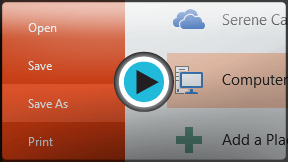PowerPoint 2013
Saving and Sharing
Introduction
Whenever you create a new presentation in PowerPoint, you'll need to know how to save in order to access and edit it later. As in previous versions of PowerPoint, you can save files to your computer. If you prefer, you can also save files to the cloud using OneDrive. You can even export and share presentations directly from PowerPoint.
OneDrive was previously called SkyDrive. There's nothing fundamentally different about the way OneDrive works—it's just a new name for an existing service. Over the next few months, you may still see SkyDrive in some Microsoft products.
Save and Save As
PowerPoint offers two ways to save a file: Save and Save As. These options work in similar ways, with a few important differences:
- Save: When you create or edit a presentation, you'll use the Save command to save your changes. You'll use this command most of the time. When you save a file, you'll only need to choose a file name and location the first time. After that, you can just click the Save command to save it with the same name and location.
- Save As: You'll use this command to create a copy of a presentation while keeping the original. When you use Save As, you'll need to choose a different name and/or location for the copied version.
To save a presentation:
It's important to save your presentation whenever you start a new project or make changes to an existing one. Saving early and often can prevent your work from being lost. You'll also need to pay close attention to where you save the presentation so it will be easy to find later.
- Locate and select the Save command on the Quick Access Toolbar.
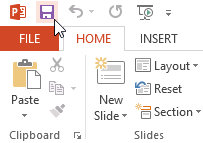 Clicking the Save command
Clicking the Save command - If you're saving the file for the first time, the Save As pane will appear in Backstage view.
- You'll then need to choose where to save the file and give it a file name. To save the presentation to your computer, select Computer, then click Browse. Alternatively, you can click OneDrive to save the file to your OneDrive.
 Clicking Browse
Clicking Browse - The Save As dialog box will appear. Select the location where you wish to save the presentation.
- Enter a file name for the presentation, then click Save.
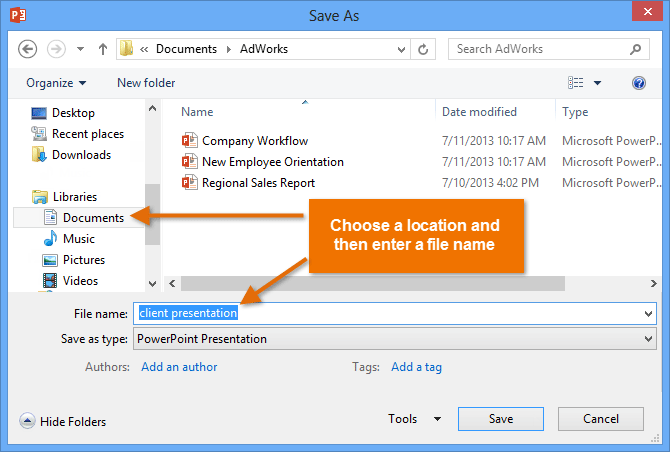 Saving a presentation
Saving a presentation - The presentation will be saved. You can click the Save command again to save your changes as you modify the presentation.
You can also access the Save command by pressing Ctrl+S on your keyboard.
Using Save As to make a copy
If you want to save a different version of a presentation while keeping the original, you can create a copy. For example, if you have a file named "Client Presentation" you could save it as "Client Presentation 2" so you'll be able to edit the new file and still refer back to the original version.
To do this, you'll click the Save As command in Backstage view. Just like when saving a file for the first time, you'll need to choose where to save the file and give it a new file name.
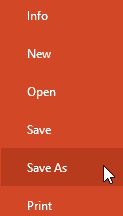 Clicking Save As
Clicking Save AsTo change the default save location:
If you don't want to use OneDrive, you may be frustrated that OneDrive is selected as the default location when saving. If you find it inconvenient to select Computer each time, you can change the default save location so Computer is selected by default.
- Click the File tab to access Backstage view.
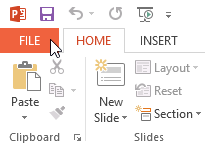 Clicking the File tab
Clicking the File tab - Click Options.
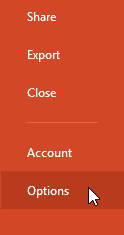 Clicking Options
Clicking Options - The PowerPoint Options dialog box will appear. Select Save, check the box next to Save to Computer by default, then click OK. The default save location will be changed.
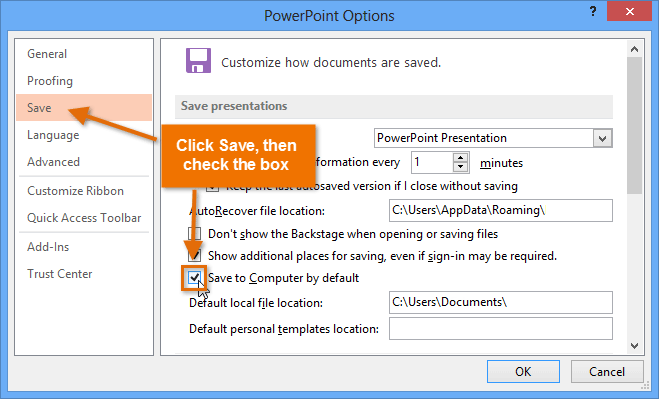 Changing the default save location
Changing the default save location
AutoRecover
PowerPoint automatically saves your presentations to a temporary folder while you are working on them. If you forget to save your changes or if PowerPoint crashes, you can restore the file using AutoRecover.
To use AutoRecover:
- Open PowerPoint 2013. If autosaved versions of a file are found, the Document Recovery pane will appear.
- Click to open an available file. The presentation will be recovered.
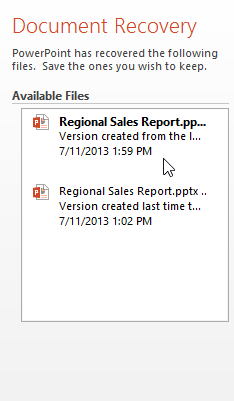 The Document Recovery pane
The Document Recovery pane
By default, PowerPoint autosaves every 10 minutes. If you are editing a presentation for less than 10 minutes, PowerPoint may not create an autosaved version.
If you don't see the file you need, you can browse all autosaved files from Backstage view. Just select the File tab, click Manage Versions, then choose Recover Unsaved Presentations.
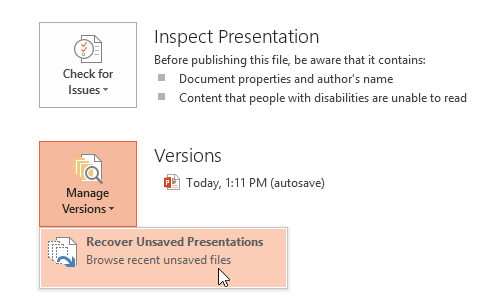 Recovering an unsaved file
Recovering an unsaved fileExporting presentations
By default, PowerPoint presentations are saved in the .pptx file type. However, there may be times when you need to use another file type, such as a PDF or PowerPoint 97-2003 presentation. It's easy to export your presentation from PowerPoint in a variety of file types:
- PDF: Saves the presentation as a PDF document instead of a PowerPoint file
- Video: Saves the presentation as a video
- Package for CD: Saves the presentation in a folder along with the Microsoft PowerPoint Viewer, a special slide show player anyone can download
- Handouts: Prints a handout version of your slides
- Other file type: Saves in other file types, including PNG and PowerPoint 97-2003
To export a presentation:
In our example, we'll save the presentation as a PowerPoint 97-2003 file.
- Click the File tab to access Backstage view.
- Click Export, then choose the desired option. In our example, we'll select Change File Type.
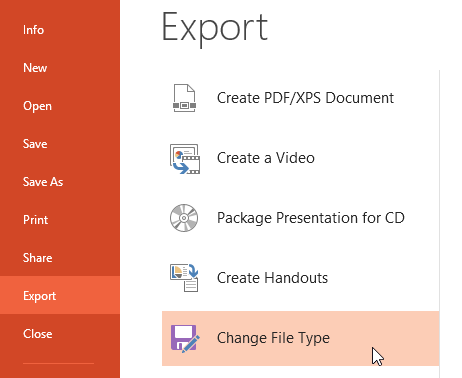 Clicking Change File Type
Clicking Change File Type - Select a file type, then click Save As.
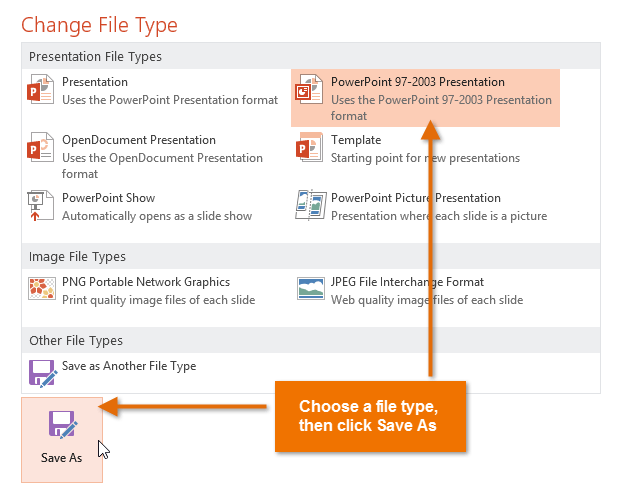 Choosing a file type and clicking Save As
Choosing a file type and clicking Save As - The Save As dialog box will appear. Select the location where you wish to export the presentation, type a file name, then click Save.
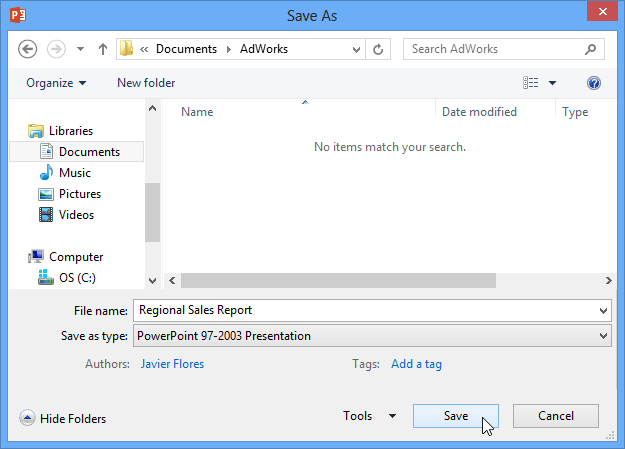 Saving as an PowerPoint 97-2003 presentation
Saving as an PowerPoint 97-2003 presentation
You can also use the Save as type: drop-down menu in the Save As dialog box to save presentations in a variety of file types. Be careful to choose a file type other people will be able to open.
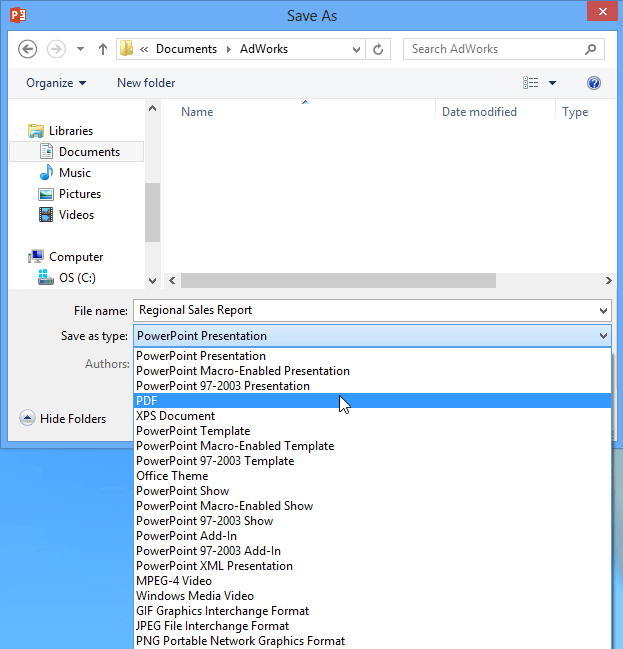 Choosing a file type from the Save As dialog box
Choosing a file type from the Save As dialog boxSharing presentations
PowerPoint 2013 makes it easy to share and collaborate on presentations using OneDrive. In the past, if you wanted to share a file with someone you could send it as an email attachment. While convenient, this system also creates multiple versions of the same file, which can be difficult to organize.
When you share a presentation from PowerPoint 2013, you're actually giving others access to the exact same file. This lets you and the people you share with edit the same presentation without having to keep track of multiple versions.
In order to share a presentation, it must first be saved to your OneDrive.
To share a presentation:
- Click the File tab to access Backstage view, then click Share.
 Clicking Share
Clicking Share - The Share pane will appear.
Click the buttons in the interactive below to learn more about different ways to share a presentation.
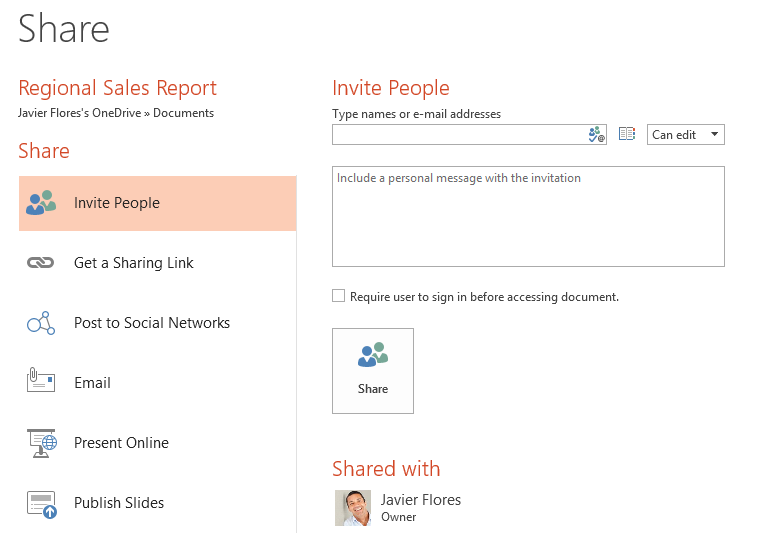
Publish Slides
Many businesses use Microsoft SharePoint to share files at work. Here, you can publish your slides to a slide library or Microsoft SharePoint location.

Present Online
From here, you can share your presentation online as a live presentation. This may be especially helpful during conference calls.
PowerPoint will generate a link that others can open in their web browser. You can pause to make changes to the presentation and then resume the slide show.
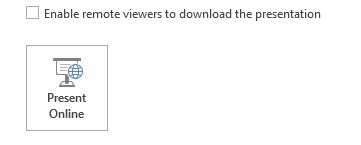
If you have Outlook 2013 installed on your computer, you'll be able to send your presentation as an email attachment directly from PowerPoint.
Keep in mind that sharing a separate copy means you won't be able to collaborate on the same file. We recommend using the Invite People option if you'd prefer to work with only one file.
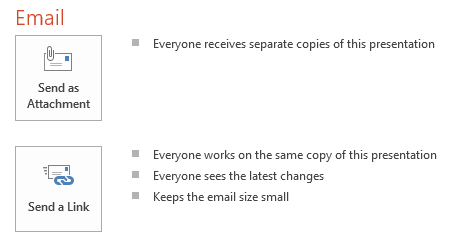
Post to Social Networks
From here, you can post a link to your presentation on any social network that you've connected with your Microsoft account, such as Facebook or LinkedIn.
You'll also have the option to include a personal message and set editing permissions.

Get a Sharing Link
From here, you can obtain a link that you can use to share your presentation. For example, you could post the link on your blog, or email it to a larger group of people. You'll decide if the link allows people to edit or just view the presentation.

Invite People
From here, you'll be able to invite others to view or edit the presentation. We recommend using this option most of the time, as it gives you the greatest level of control and privacy when sharing a presentation.
This option is selected by default whenever you access the Share pane.
Share Options
This pane will change depending on which sharing method you select. You'll be able to choose various options to control how you share your presentation.
For example, you can decide if the people you share with will have permissions to edit or just view the document.
Challenge!
- Create a new presentation.
- Use the Save command to save the presentation to your desktop.
- Save the presentation to OneDrive and invite someone else to view it.
- Export the presentation as a PDF file.



